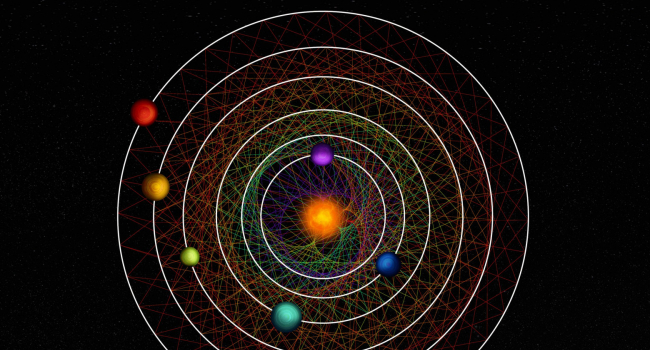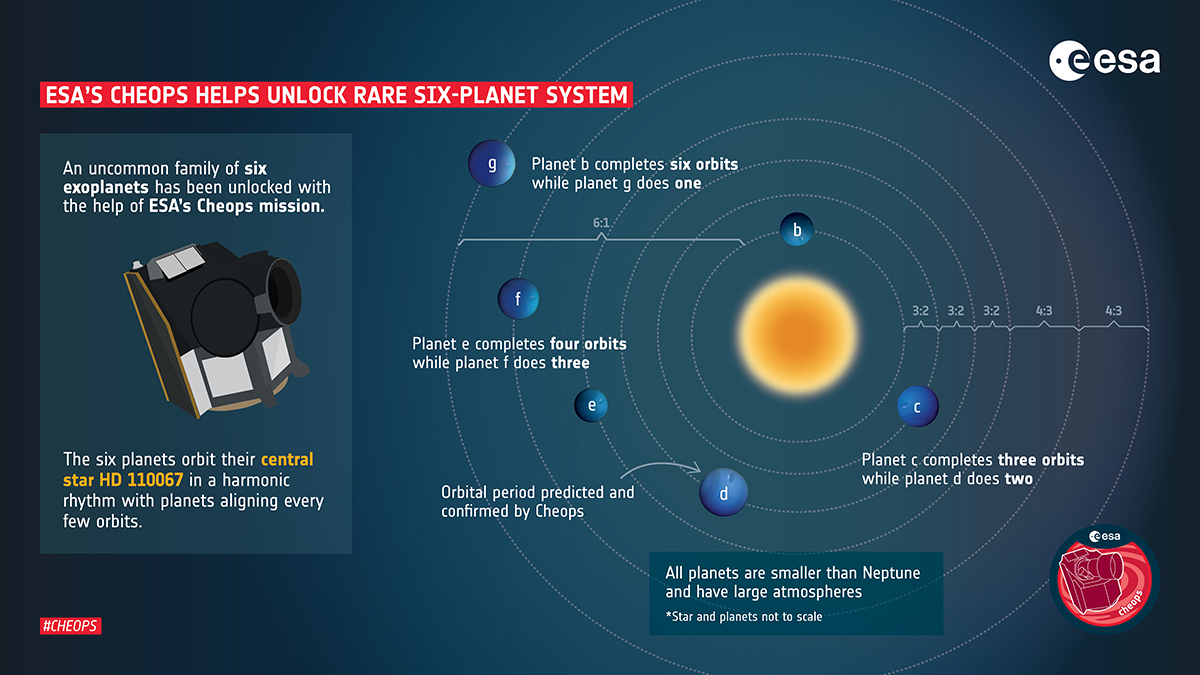
Scientists discover rare system of 6 planets that move in surprising harmony
The research conducted by astronomer Raphael Luke from the University of Chicago could shed light on the formation of planets. Scientists have discovered a rare spectacle in a neighboring star system – six planets orbiting a central star in an astonishing rhythm. The planets move in an orbital waltz so precisely that it can easily be synchronized with music.
As a rare case of "synchronous" gravitational locking, this system could provide profound insights into the formation and evolution of planets. The analysis conducted by Chicago's Raphael Luke was published on November 29 in the journal Nature.
"This discovery will serve as a benchmark system for studying how sub-Neptunes, the most common type of planets beyond the Solar System, form, evolve, what they are made of, and whether they have suitable conditions to sustain liquid water on their surfaces." — Raphael Luke
This animation by Dr. Hugh Osborne, University of Bern illustrates six exoplanets of the "sub-Neptune" type rhythmically orbiting their star as each planet crosses a line drawn through the system. This line represents the intersection of the planets in front of their star ("transit") from the Earth's perspective. In these rhythms, known as "resonance," the innermost planet completes three revolutions for every two revolutions of the next planet. Among the farthest planets, the pattern of four orbits for every three of the next planet repeats twice.
Rare Resonance
Six planets orbit the star HD110067, located approximately 100 light-years away from us in the northern constellation of Coma Berenices (Berens's Hair). In 2020, NASA's TESS detected a decrease in the star's brightness, indicating that the planets were passing in front of the star's surface. By combining data from NASA's TESS and the European Space Agency's CHEOPS, a group of researchers analyzed the data and discovered a one-of-a-kind configuration.
Although multi-planet systems are common in our galaxy, systems in gravitational resonance are observed very rarely. In this case, the planets closest to the star complete three revolutions for every two of the next planet — a resonance known as 3/2. The first four planets adhere to this rule, while the fifth completes four orbits for every three of the sixth (resonance 4/3).
"It shows us a rare configuration of a planetary system that has remained untouched," Raphael Luke said.
These resonant orbits are reliable, indicating that the planets have likely been performing the same rhythmic dance since the system formed billions of years ago.

Formation History
Orbital resonance systems are extremely crucial for astronomers as they narrate the story of the formation and subsequent evolution of planetary systems. Planets around stars typically form in resonance but can be easily perturbed. For instance, a very massive planet, a close encounter with a passing star, or a giant collision event — all these factors can disrupt the delicate balance. As a result, many well-known multi-planet systems, while not in resonance, appear close enough that they might have been resonant at some point. However, multi-planet systems that maintain their resonance are exceptionally rare.
"We estimate that only about one percent of all systems remain in resonance, and even fewer display a chain of planets in such a configuration," said research lead Raphael Luke. This is why the HD110067 system is unique and warrants further investigation: "It shows us the pristine configuration of a planetary system that has remained untouched." More precise measurements of the masses and orbits of these planets will be needed for further refinement of the system's formation picture.
- Related News
- Wheel of Death: new method will help astronauts stay fit in low gravity
- Due to anomalies of Orion spacecraft, lunar exploration program may be delayed for years։ NASA
- TAO Observatory: World's highest telescope to study evolution of galaxies and exoplanets
- Powerful M9.5 solar flare causes radio blackout in Pacific Ocean
- What will happen to the Earth if the Moon disappears?
- Key to conquering the Red Planet: Why is NASA studying solar storms on Mars?
- Most read
month
week
day
- Digital Julfa Network is launching a pan-Armenian centre in the metaverse, on the Fastexverse virtual platform 901
- Sparkles: Boston Dynamics unveils a furry robot dog that can dance (video) 789
- Xiaomi unveils exclusive Redmi Note 13 Pro+ dedicated to Messi and Argentina national team 770
- Is there a ninth planet in the solar system? Scientists find new evidence 668
- Smartphone catches fire in child's hand in Russia 654
- What will happen to the Earth if the Moon disappears? 642
- How to understand how protected a smartphone is from water and dust? 629
- World's largest 3D printer was created in USL It prints 29 meter-long structures 619
- iPhone 16 may get colored matte glass back panel, 7 colors 608
- New iPad Pro to receive M4 chip and to be more powerful than Apple computers 605
- Archive
